The ASUS Republic of Gamers G751 Review: G-SYNC Comes To The Notebook Computer
by Brett Howse on July 29, 2015 8:30 AM ESTGaming Performance
As a gaming laptop, this may be the only page of the review that matters to some people. The NVIDIA GTX 980M has graced our test bench several times already, and unsurprisingly it is very potent. ASUS has shipped the 4GB model, whereas MSI has the 8GB GTX 980M in the GT72 and GT80 SLI models. At the 1920x1080 resolution of these systems, 4GB should not be an issue for the moment, and as Ryan brought up in the R9 Fury X review, it is really when gaming at UHD where you may run into a VRAM limit. With the performance available from a GTX 980M though, gaming at UHD is going to be possible without some of the settings turned down. This shouldn’t be an issue though unless you are going to hook the G751 up to an external UHD monitor.
Our standard notebook GPU workload starts with some synthetics, then moves to our gaming tests.
3DMark
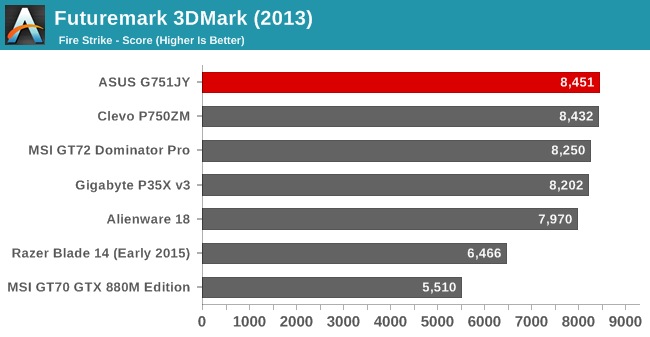
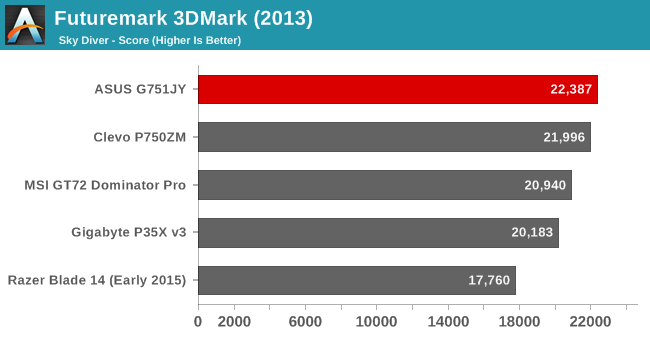

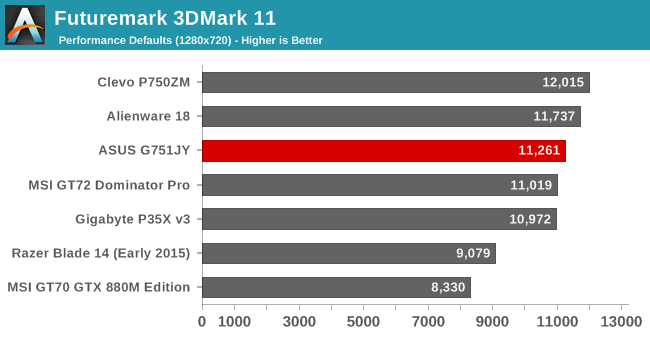
The G751 is off to a good start, scoring right in line with the other devices with a GTX 980M. As a synthetic test, it focuses several of the tests on the GPU and a couple of the physics test are handled by the CPU.
Bioshock Infinite
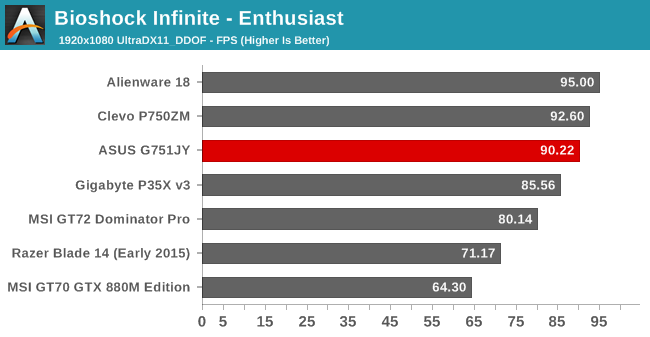
Bioshock Infinite is getting a bit long in the tooth now, but it is really a fantastic game so it will be sad to see it go. We like to keep a couple of older games like this around though in order to see performance trends over time. The G751 has no issues with this test at 1920x1080, scoring 90 frames per second as an average. This is well over the 75 Hz panel refresh rate, but G-SYNC might still be useful here in areas where there is a lot of action going on at the same time.
Tomb Raider
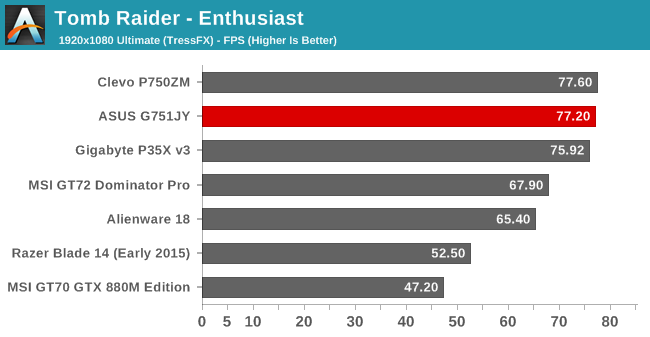
I am quite excited to see the sequel to this game, which was a fantastic reboot of the Lara Croft franchise. Our enthusiast settings for this game include TressFX, which can be fairly punishing to a lot of GPUs. The G751 scores quite well again though, coming in with an average of just over 77 frames per second. This is awfully close to the 75 Hz refresh of the panel though, so in this title, G-SYNC would be very useful. I spent some time running around the environment and came away impressed with how smooth the gameplay is with G-SYNC turned on.
GRID Autosport
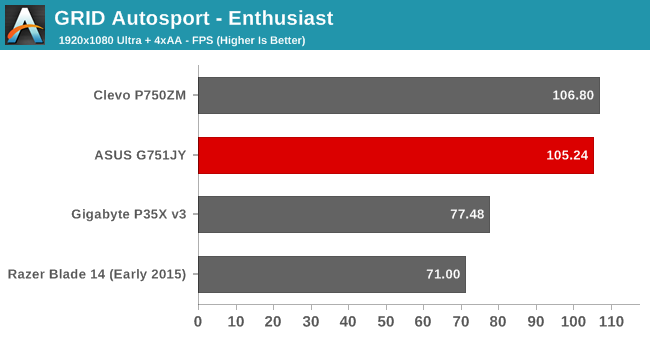
This is a new addition to the test suite for 2015, and it is the latest GRID game from Codemasters. SLI doesn’t seem to help as much in this game, but the G751 scores very well, coming in close to the Clevo which is pushed ahead by its desktop CPU.
Civilization: Beyond Earth

Another new addition to the test suite for 2015 is the latest turn-based strategy game based on the classic Sid Meier’s Civilization franchise. Once again the G751 has a good showing, edging out the other single GPU based systems in this test.
Shadows of Mordor
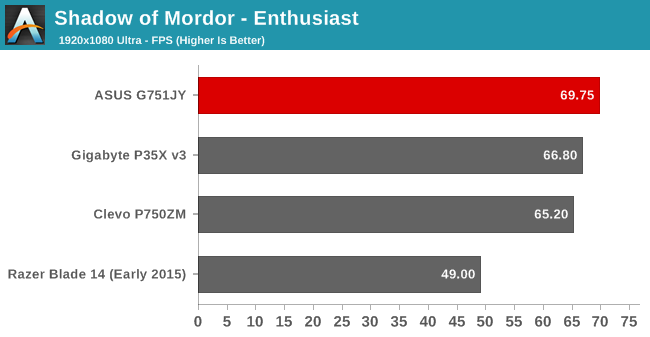
With this game set at Ultra quality, it falls just under the panel refresh rate, so G-SYNC would be well suited to this game. The G751 once again outscores all of the other single GPU systems in this test, despite having less VRAM available. This game is certainly one that can chew through VRAM, but only if the resolution is quite high.
Dragon Age: Inquisition
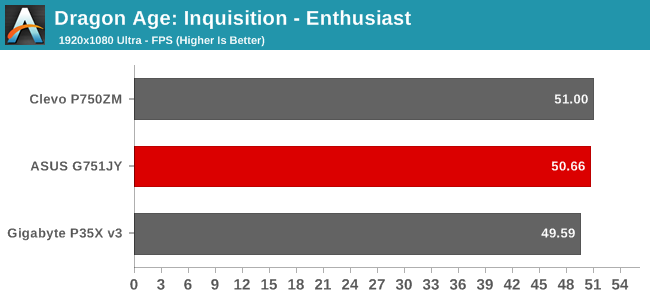
Next up is the fantastic RPG from Bioware. On a side note, I just finished this game and for me, it ranks up there with the best RPGs ever. At maximum settings, the graphics can be fairly demanding, and the average framerate of just 50 frames per second is really the first that is well under the 75 Hz refresh rate of the panel. G-SYNC would be a big benefit in this game, allowing you to keep the settings at Ultra but still be nice to play.
DOTA 2

DOTA 2 was added to the test suite since it is a game that is well suited to being played on an integrated GPU, but those systems can struggle for framerate when you max out all of the quality settings at 1080p. A system with a dedicated GPU is going to be much better as you can see from the scores.
GPU Summary
Closing out the GPU results, the G751 scores right in line with the other GTX 980M systems despite it being the first one we’ve tested with 4GB of VRAM. At the lower resolution that large display notebooks seem to be stuck in, 4GB is likely not going to be an issue. The cooling system had no problems in any of these tests, allowing the CPU and GPU to maintain higher frequencies and edge out some of the other systems.










52 Comments
View All Comments
nathanddrews - Wednesday, July 29, 2015 - link
Does Intel plan on taking advantage of the Adaptive Sync tech anytime soon? I know they use it for other things for power saving (self-refresh, etc.), but it sure seems like a golden opportunity.In the same vein - given that we know (and have known for some time) that the G-Sync module is not required if you have eDP/DP1.2a, when can we expect a shift to tech-agnostic displays? Do we have to wait for DP1.3?
DanNeely - Wednesday, July 29, 2015 - link
I know eDP/DP1.2a provides a similar feature set to G-Sync; but has nVidia actually said anything about adopting it instead of (in addition to?) their current custom hardware implementation?DanNeely - Wednesday, July 29, 2015 - link
I suppose I deserve what I get for commenting before reading the 2nd page of the article; but as long as they're requiring additional qualification work to approve a panel for GSync, there's still plenty of potential to cause trouble for cross GPU support if they wanted to.nathanddrews - Wednesday, July 29, 2015 - link
VESA's Adaptive Sync is a part of eDP and DP 1.2a+. It's there, waiting to be used. G-Sync, FreeSync, and whatever Intel does are just the names for how they utilize it.The only reason NVIDIA pursued a custom module was because no desktop monitors - at the time - included A-Sync. Screens connected via eDP can. As we move forward with newer and newer displays, we're likely to see more and more of them be A-Sync-capable, which means being able to support any variable refresh technology, whatever the marketing label is. Whether or not those displays end up as G-Sync, FreeSync, or some sort of hybrid is up to the manufacturers, I suppose. Just like with G-Sync and FreeSync displays, optimizing the display will still be important.
Ideal situation: connect monitor to computer, GPU drivers load a default profile based upon EDID for frequency range and resolution support, advanced users can tweak (under/overclock/etc.), maybe share firmware, etc. to crowd-source calibration settings. Shipping a monitor back to a manufacturer for an update is ridiculous...
lefty2 - Thursday, July 30, 2015 - link
> The only reason NVIDIA pursued a custom module was because no desktop monitors - at the time - included A-Sync.This is not true. When AMD created FreeSync the DisplayPort 1.2a monitors did not exist either, but instead of creating a propierty solution, they got FreeSync incorperated into the open standard. Nvidia could have done the same thing, but they prefer using propierty standards to lock the customers in.
nathanddrews - Thursday, July 30, 2015 - link
Interesting version of history you've created.DP1.2a display availability lagged behind G-Sync Module display availability by more than a year. If NVIDIA pursued the VESA solution, G-Sync would have been delayed alongside FreeSync. The G-Sync module was absolutely required to get a jump on the market since DP1.2 did not include the Adaptive Sync option. You may not LIKE it, but that's the how it happened.
lefty2 - Thursday, July 30, 2015 - link
DP1.2a display availability also lagged behind FreeSync... AMD just waited had to wait for them to come available (in fact they pushed the standard forward) and Nvidia could have done the same.LoganPowell - Friday, November 27, 2015 - link
ASUS does overall make fantastic computers, but I'd recommend going for the Dell Inspiron i7559-763BLK. Highly approved by many gaming enthusiasts. /Logan from http://www.consumerrunner.com/top-10-best-laptops/Creig - Thursday, July 30, 2015 - link
"additional qualification" = give us money to use the G-sync name.Shadowmaster625 - Wednesday, July 29, 2015 - link
I have a great idea. Let's build Optimus notebooks for five years, and then all the sudden build one without it! Isnt that a great frickin idea? I need to be CEO of Asus.